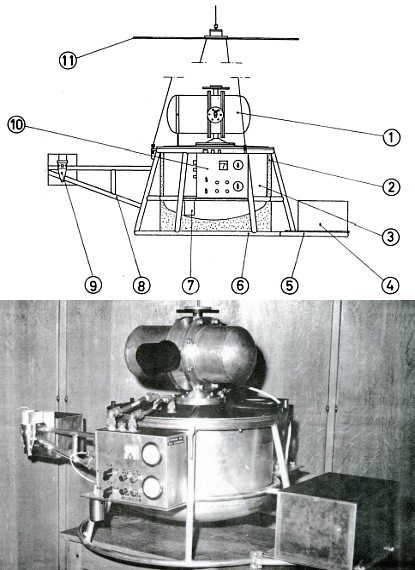Purpose of the flight and payload description
The objective of the flight was the measurement of in situ ultraviolet solar irradiance in the range of 200-240 nm. From spectra obtained for different solar elevations, the ultraviolet irradiance outside the earth's atmosphere was deduced by extrapolation to zero air mass. These studies were important for understanding the ozone budget in the stratosphere as stratospheric ozone is mainly produced by the photodissociation of molecular oxygen in the upper stratosphere, around 40 km altitude.
To study this optical window, the Belgisch Instituut voor Ruimte-Aeronomie / Institut d'Aéronomie Spatiale de Belgique (BIRA-IASB) developed a balloon-borne ultraviolet spectrometer schematized in the figure at left (click to enlarge). The gondola was divided into two compartments, one for optics pressurized with nitrogen and the other pressurized with dry air containing the electronics. The envelope of the monochromator (1) was fixed above a pressurized tank (3) surrounded by a thermal insulation (2). The gondola was placed in a cradle (6) intended to absorb the shock when returning to the ground by parachute. This cradle also supported a switch (4) to control the correct operation of the equipment, a pressure gauge (7) and a thermometer (9). The control panel (10) enabled the programmed starting and stopping of the assembly, the load of the accumulator batteries and overall control of operation. The gondola was suspended below the balloon and the latter was hidden from the optical system by means of a cover blackened with a paint chosen for its very low reflective power in the ultraviolet (11). A high-precision manometer and an air temperature measuring thermometer were the other essential elements of the gondola.
The optical system was formed by as dispersive system, a monochromator of the Czerny-Turner type in which the light entered after scattering by a frosted quartz whose indicator was measured at laboratory and whose characteristics have been verified in flight. The dispersive element is a 3 x 3 cm Bausch and Lomb grating engraved with 1200 lines per mm and reinforced at the wavelength of 2000 �. The detector placed behind the exit slit was a cadmium cathode photomultiplier which has the property of being sensitive only to radiation with a wavelength of less than 3000 �. This property made it possible to avoid stray light which could considerably interfere with the measurements. The photomultiplier was powered by a 2000 V high voltage supply and the current it supplied was measured by means of an electrometer with automatic sensitivity change which has a dynamic range of one million.
The data obtained in flight was transmited to the ground via a FM based telemetry system.
Details of the balloon flight
Balloon launched on: 5/10/1968
Launch site: Centre de Lancement de Ballons CLBA, Aire Sur L'Adour, Landes, France
Balloon launched by: Centre National d'Etudes Spatiales (CNES)
Balloon manufacturer/size/composition: Zero Pressure Balloon
End of flight (L for landing time, W for last contact, otherwise termination time): 5/10/1968
External references
- Mesure du rayonnement ultraviolet solaire par ballon stratosphérique Ciel et Terre, Vol. 84, p. 408
- New ultraviolet solar flux measurements at 2000 � using a balloon borne instrument Aeronomica Acta, Issue 84 (1971)
- New Ultraviolet Solar Flux Measurements at 2000 � Using Balloon-Borne Instrument New techniques in Space Astronomy. IAU Symposium no. 41, held in Munich, Aug. 10-14, 1970. Edited by F. Labuhn and Reimar Lust. International Astronomical Union. Symposium no. 41, Dordrecht, Reidel, p.251
- Solar UV radiation In "50 years of research at the Belgian Institute for Space Aeronomy" pag. 91
6212If you consider this website interesting or useful, you can help me to keep it up and running with a small donation to cover the operational costs. Just the equivalent of the price of a cup of coffee helps a lot.


